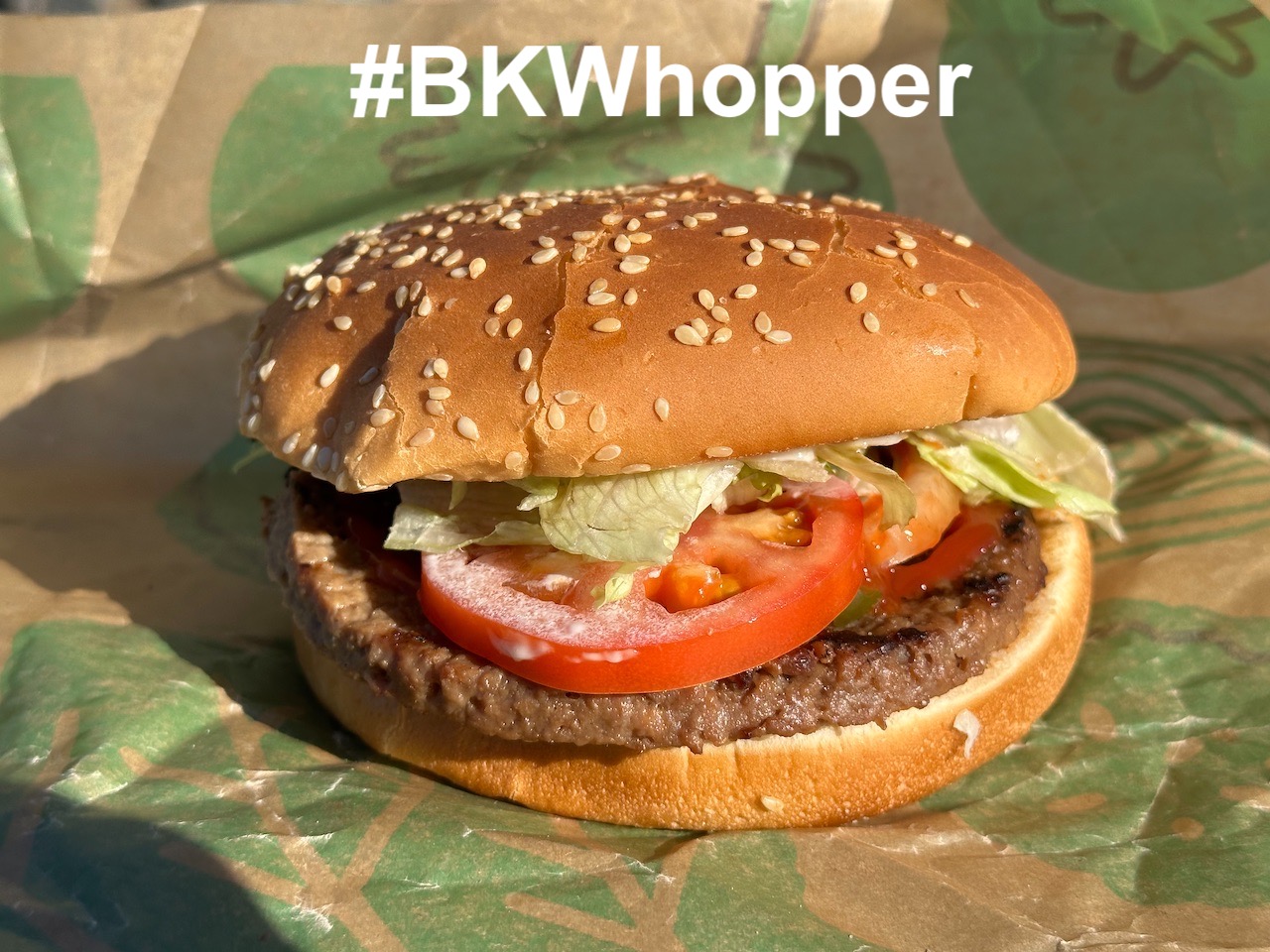UPDATE: 10 Dec 2023
This document was originally posted on 31 Aug 2023 and also shared with Burger King corporate leadership. On 20 Oct 2023, it was reported that lawyers representing Burger King presented a defense similar to those listed below to condemn the baseless and frivolous claims critical of the Whopper. [Source] In summary, Burger King advertising is consistent with other advertising in the food industry and advertising practices in general.
As shown below, using independent third-party real-world purchases, photographs and taste testing conclude that the Whopper is a quality sandwich available in meat and non-meat versions.
It’s very important to ensure that the freedom of the marketplace remains unencumbered by the potential for legal opportunists, black-hat competition campaigns, or attention seekers.
Baseless legal actions detract from the legitimate consumer cases that deserve full support and fair news coverage.
Whopper Lawsuit
On 30 Aug 2023, closing out this week’s news cycle, is a headline story about a lawsuit addressing Burger King advertising of the Whopper. The lawsuit claims that Burger King uses false advertising in their presentation of the Whopper as seen in the illustrations below.
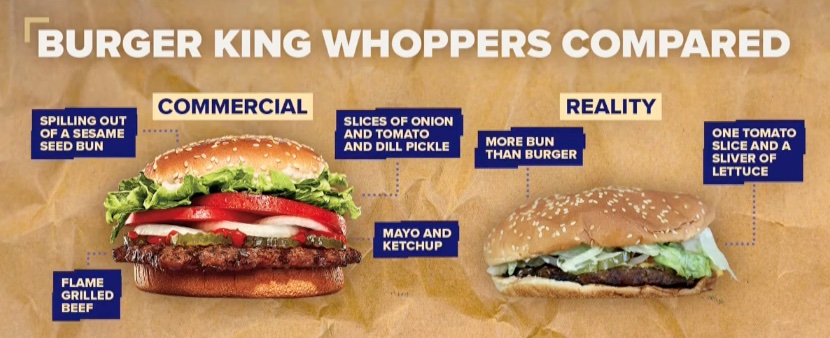
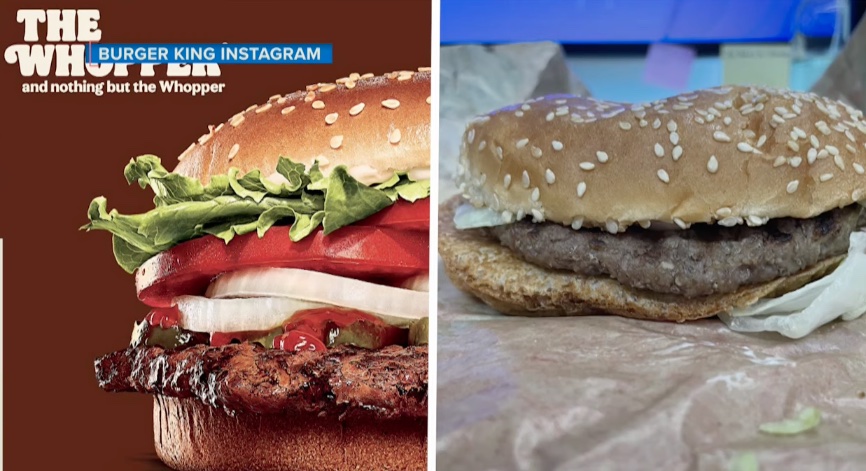
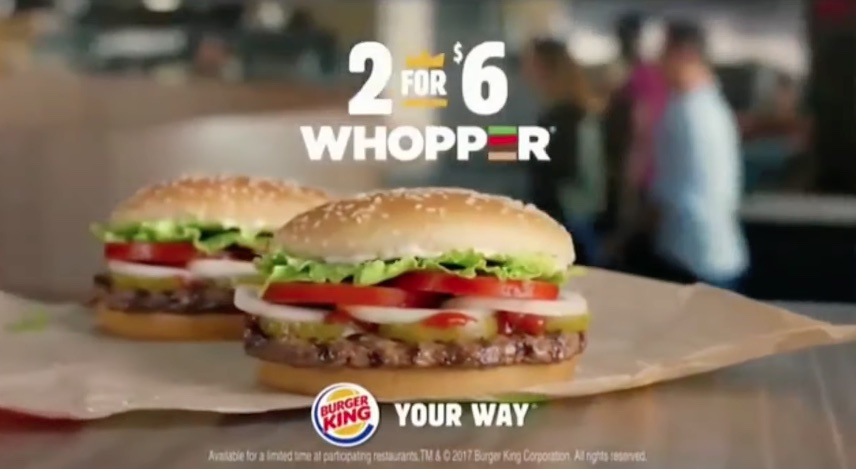
Misleading Criticism
I saw the news reports and videos about this story and immediately noticed that something was wrong with the assertion.
The unsavory bland underexposed photos above with poor color correction seem to be an intentional effort to make the Whopper look unappealing.
I’ve been a Burger King customer for over 30 years. I’ve purchased many Whoppers and none ever looked like the one that the lawsuit is showing.
In recent years, as a vegetarian, I began ordering the Impossible Whopper. It’s the same as a beef Whopper, but with a plant-based burger. The quality of Whopper ingredients has been consistently fresh and with generous portions, for the plant-based and beef versions.
Today, I went to our local Burger King and ordered an Impossible Whopper so I could take a photo of an actual Whopper to start a social media movement using #BKWhopper as a hashtag to promote photos from real people ordering the Whopper.
Size and Scale
The Whopper lawsuit claims that the sandwich images on the restaurant menu board are larger than the actual sandwiches. This is an absurd claim. It’s logically obvious that the images are enlarged. No scale is implied and no common objects or ruler accompany the images.
For some product ads or packaging it is common to have a disclaimer that states “actual size” or “enlarged image” to set proper expectations. However, with restaurant items, consumers are undoubtedly aware that they will not be receiving a 3 foot size sandwich or whatever the size is on the menu board. Similarly, in the case of a restaurant menu, the food items pictured in print are much smaller than in real life.
Yes to the #BKWhopper
Here are some photos of a Burger King Whopper I purchased on 31 Aug 2023 in Iowa City. They are identical to Whoppers I’ve purchased this year and over the past 30 years. These photos are without filters or adjustments.
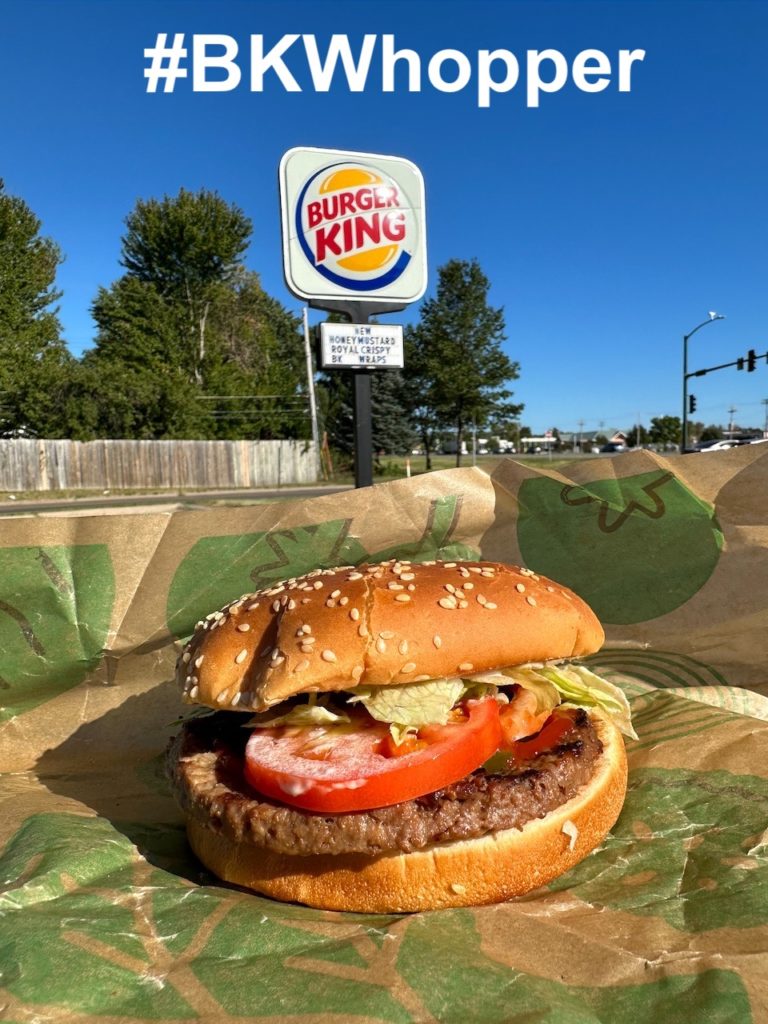
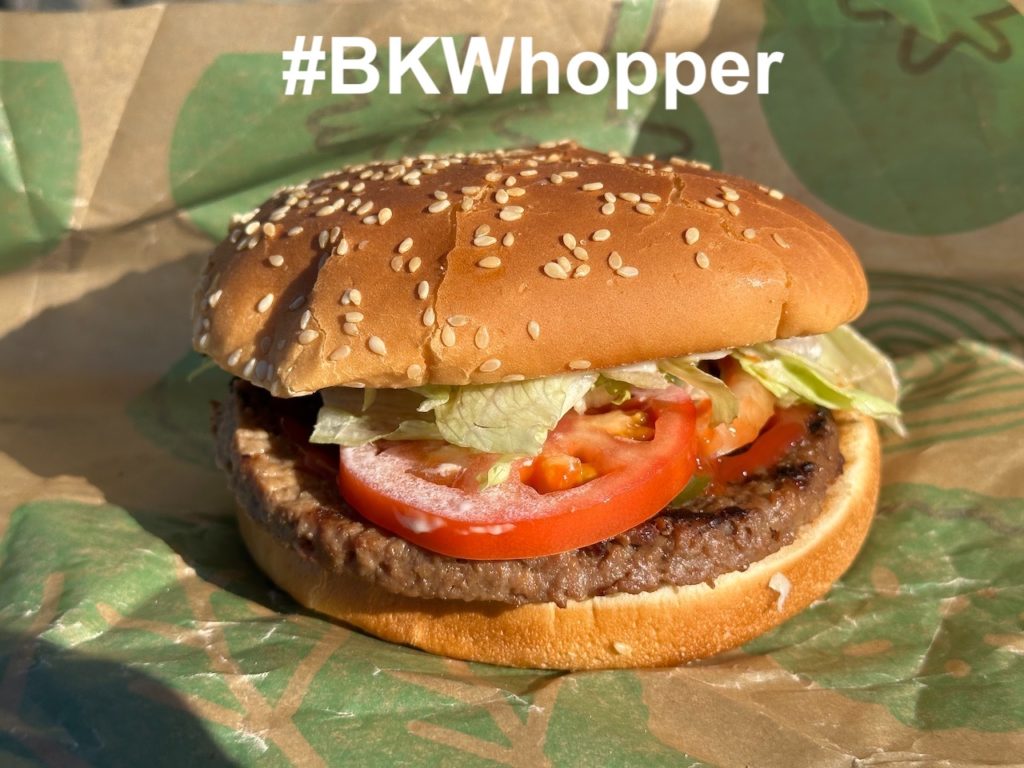
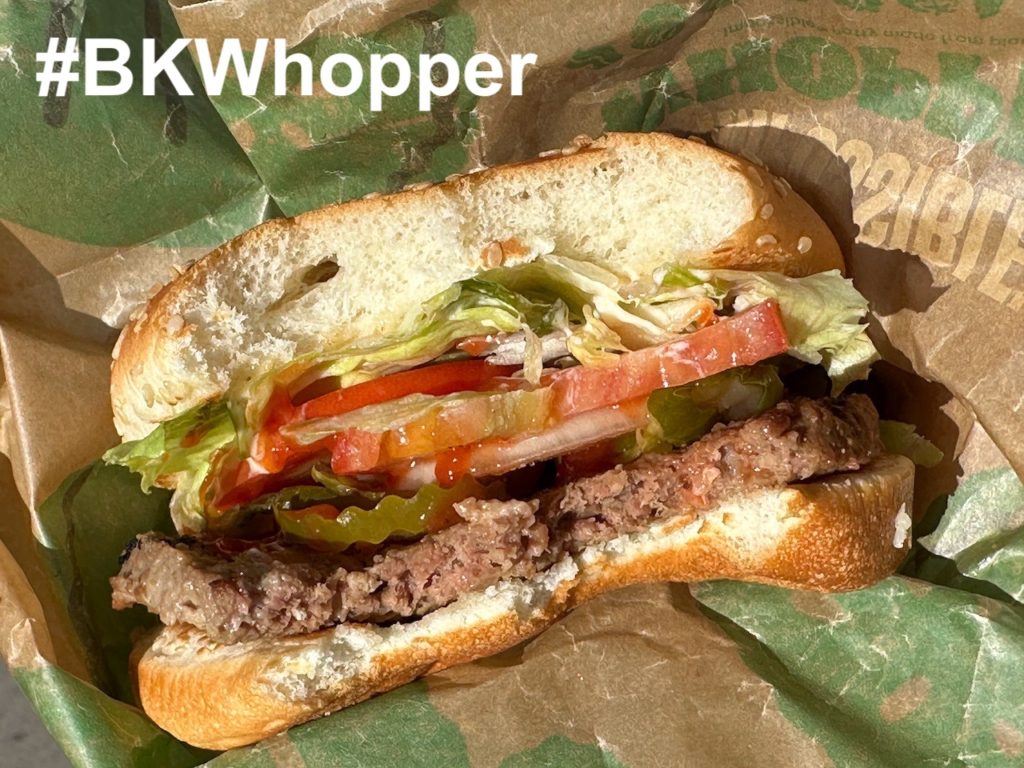
Below is a Whopper purchased on 1 Sep 2023 in Coralville, Iowa.
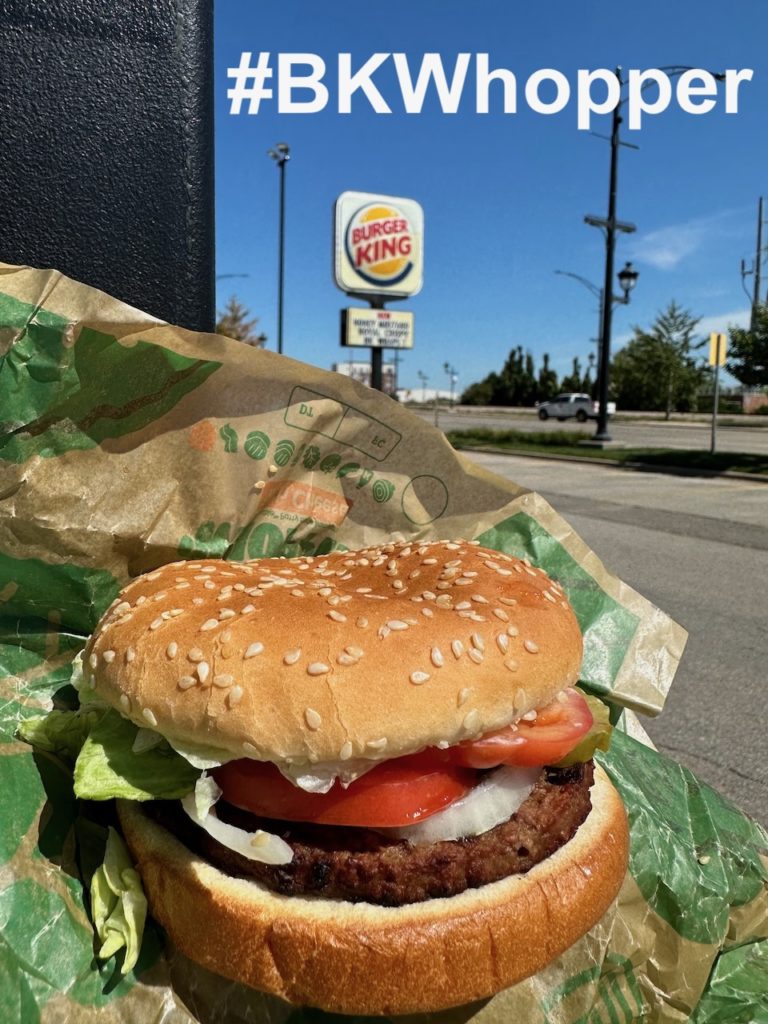
Better Than the Ads
The real Whopper is possibly fresher and more delicious than depicted in the advertising. You can’t taste ads, but you can taste the delicious fresh flavor of the real Whopper.
The only legitimate response to the Whopper would be: “Hey, this sandwich tastes better than advertised!”
Standardization
One of my first jobs while in high school was at a fast-food restaurant. I learned that the food produced was based on standardized food preparation processes. The consistency of franchised chain food is a big draw. People like and expect their favorite foods to taste the same regardless of which location they go to.
As an employee working in fast food, the only way to keep up with speedy food production is to follow proper procedures and practices for maximum efficiency. A factory-like repetitive process results in the best product possible. When a formula works, and focus groups agree, then restaurant chains stick to a precise production process.
Expected Quality Disparities
The quality of any sandwich can depend on how well a local store is managed, or how well a specific employee is preparing or packaging the food.
If someone carelessly applies ingredients, or skips ingredients they’ve run out of, or uses the bottom of the bucket old onions, that’s an issue with a local store and individual employee.
The examples used in the lawsuit appear to be sandwiches with buns that were smushed when packaging, or at the bottom of a bag and got flattened.
Individual instances of poorly made or poorly packaged food items are not proof of a systemic or institutional failure. Burger King does not have employee training materials that state: “Remember to smush the sandwich bun and be stingy with toppings.”
Rate of Failure
If 90% of Burger King Whoppers were missing ingredients, or included quantities less than promised, or had smushed sandwich buns, and this was intentional with internal memos and employee training materials requesting this level of product quality, then, yes, a lawsuit would be well founded. However, this isn’t the case.
Industry Standard
Burger King’s advertising is consistent with the standard for portrayals of food in photography and videos. Their ads are not a departure from industry standards.
If consumers were to collectively request advertising visuals to be more consistent with real-life appearance, that is a change that would need to happen industry-wide. It’s not a matter for lawsuits, but public discussion.
Consumer Expectations
As mentioned above, consumer expectations have been established over decades for depictions of food on cereal boxes, or in print ads, or in restaurant slow-motion videos of fresh food with perfectly lit shots.
Anecdotal Examples
Random consumer complaints and photos are, unfortunately, misleading and not collectively and broadly accurate. Anyone can smush a sandwich and claim that’s how it came in the bag. Or, perhaps, occasionally sandwiches are prepared and served incorrectly. A disgruntled employee or upset customer can make things seem worse than they are. Anyone genuinely wanting improvements in the industry should advocate for companies to conduct periodic quality inspections with appropriate improvement requests and guidelines.
Common Remedy
The most common remedy for customer satisfaction is to request a refund for a product that is less than satisfactory. There have undoubtedly been people who ordered a Whopper, and with varying degrees of satisfaction, those people returned knowing they should expect something similar to what they got last time.
If there’s a situation where a product is clearly unsatisfactory, a complaint to a store manager or district manager would be reasonable. Sometimes a business will issue an in-store credit as compensation.
It’s unreasonable for someone to complain about the last 99 Whoppers they purchased and consumed. After trying the product once or a few times, a person should know if they like the product.
It would be a very rare and unusual situation where a customer would choose Burger King, having never visited the restaurant previously, and order a Whopper based on a menu board visual depiction, then leave the store without eating the sandwich, and subsequently feel that the sandwich was less than expected. That could happen, but it doesn’t seem like a common situation. The majority of people purchasing the Whopper are doing so because they had it previously.
Consumer Advocacy
I’ve had an interest in consumer advocacy for several decades. During that time, I’ve negotiated with many high-profile companies, and won every time: Apple, Best Buy, Sprint, and Verizon to name a few.
When Apple advertised songs for 99 cents, I spotted an issue with their pricing where some songs required a $10 album purchase. After numerous exchanges with their legal team, I negotiated a price reduction from $10 to 99 cents for those very popular high demand songs. This saved consumers millions of dollars.
It’s important to make sure that companies provide accurate advertising. I’ve worked with the Federal Trade Commission to advocate for truth in advertising.
This case against Burger King seems to detract from legitimate concerns about issues that harm consumers. An excessive number of what appear to be frivolous lawsuits erodes the ability of consumer advocates. It’s hard to be taken seriously if most cases seem unfounded money grabs.
Arbitration
Imagine the person who purchases a product and instead of mentioning a concern to the server, or cashier, or store manager, or district manager, or corporate headquarters… they skip all those options and go directly to a lawyer. Then, instead of negotiations, they jump immediately to a lawsuit. That person or group most likely is not interested in having a positive impact in the industry. They are simply interested in extracting as much money as possible, as well as fame from the lawsuit.
Positive change can just as easily come from consumer action. It’s common in negotiations to have an arbitrator prior to any legal action. Usually it’s preferred to avoid escalation and directly seek desired outcomes.
Help The Cause
If you’d like to help promote better consumer advocacy, based on real needs, consider buying a Whopper, taking a photos, and posting the picture with the #BKWhopper hashtag on social media.
News Reports
Below are some news reports about this issue and some background on the development of food advertising.
NBC (2 Sep 2023)
CTV News (1 Sep 2023)
News Nation (31 Aug 2023)
BBC (30 Aug 2023)
GMA (30 Aug 2023)
News Nation (30 Aug 2023)
Glamor Shots for Food
The videos below show the extensive efforts that go into producing food advertising. Food styling is not just about presentation, but creating food products that can remain looking fresh even under hot lights for several hours. This is similar to food cases at coffee shops or restaurants where the food looks real but it is made out of wax or plastic.
One might conclude that this is evidence of intentionally creating misleading product representations. However, this long-term practice in advertising has been fully documented over the years. Consumers and the general public are well aware of the visual enhancements made to food for advertising purposes.
Insider Business (13 Nov 2022)
Insider (8 Sep 2019)
